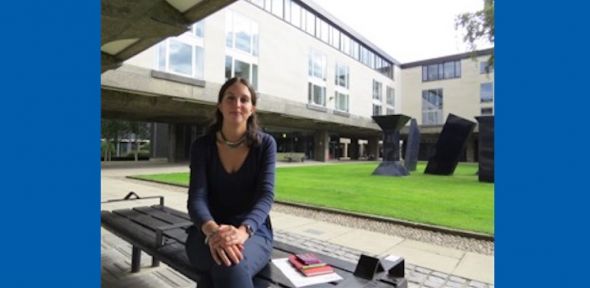
Norma Schifano – On the correlation between verb movement and negation typologies
Seminari del CLT
On the correlation between verb movement and negation typologies
NORMA SCHIFANO (University of Birmingham)
Divendres, 10 de gener de 2020
Aula 202, 15:30
(joint work with Adam Ledgeway, University of Cambridge)
- The puzzle
Across Romance, three main syntactic patterns of negation can be identified, i.e. preverbal (1a), discontinuous (1b), and postverbal (1c):
(1) a Nu a mâncat. (Ro.)
NEG have.PRS.3SG eat.PTCP
‘S/he didn’t eat.’
b No la dorm no. (Livo, NID, Manzini and Savoia 2005,III:134)
NEG SCL.3FSG= sleep.PRS.3SG NEG
‘She doesn’t sleep.’
c Je sais pas. (coll. Fr.)
I know.PRS.1SG NEG
‘I don’t know.’
In the literature, a great deal of attention has been paid to the Romance-internal microvariation in form and position of negators, to their etymology and syntactic status, as well as to the correlation between the three typologies in (1) and the three attested diachronic stages exemplified in (2) from French, traditionally known as Jespersen’s Cycle:
(2) a Je ne dis. (OFr.) (Poletto 2016:836)
I NEG say.PRS.1SG
b Je ne dis pas. (ModFr.)
I NEG say.PRS.1SG NEG
c Je dis pas. (coll. Fr.)
I say.PRS1SG NEG
‘I do not say.’
Over the decades, various aspects of Jespersen’s Cycle have been discussed and reformulated, also in the light of new empirical evidence. Topics of debate include the exact number of stages (van der Auwera 2009) and triggering factors (Parry 2013:94-95). The object of study of the present talk regards, however, another puzzle surrounding the negative cycle, namely its Romance-internal distribution. As shown in Table 1, obligatory non-emphatic postverbal negators (cf. Stages II and III) are concentrated in a continuous geographical area which includes some northeastern Ibero-Romance and several Gallo-Romance varieties, leaving about half of the Romània stranded at Stage I (Schwegler 1983:318), where optional postverbal reinforcers, when available, may only be added for emphatic purposes:
Table 1. Distribution of typologies of Romance negation
| Typologies | Distribution |
| Preverbal | European Portuguese, Spanish, Catalan, Italian, CIDs, SIDs, northeastern / some northwestern IDs, eastern Romansh, Romanian |
| Discontinuous | standard French, many NIDs |
| Postverbal | Aragonese, northern Catalan varieties, several Gallo-Romance varieties, northwestern IDs, western/central Romansh |
- Proposal
In order to account for this particular distribution, different proposals have been advanced in the literature, including German adstratum influence (e.g. Lockwood 1968:208) and reduced use of postverbal emphatic constructions (e.g. Schwegler 1983:323). In this talk, we suggest a novel hypothesis which links the attested distribution, viz. Stage I vs Stage II-III varieties, to the typologies of verb movement independently attested across Romance (Schifano 2015, 2018), as summarised in (3) (Ledgeway & Schifano in press):
(3) If a variety is at Stages II-III, it exhibits clause-medial or high verb movement.
We take (3) to follow from the fact that postverbal negators, whose nature is essentially nominal, have to be licensed as elements carrying a NEG feature and that such licensing is achieved by moving the verb through their associated FP. This explains why non-emphatic postverbal negators cannot emerge in low verb movement varieties, where the verb does not move high enough to license their NEG feature.
- Empirical evidence
The wealth of diachronic and synchronic variation offered by Italo-Romance dialects provides empirical evidence in favour of (3). First, we predict that when high/medial verb movement varieties were Stage I, they could exhibit lower verb movement, as shown by a selection of data drawn from Passione Trivulziana (1300/1400, Milan/Como), which exhibits both Stage I negation and relics of low verb movement, unlike modern Milanese (cf. Stage III and clause-medial verb movement). Second, we predict that only high/medial varieties can develop non-emphatic postverbal negators, as shown by northern colloquial varieties of Italian (e.g. Molinelli 1984) and some northeastern Italian dialects (e.g. Poletto 2016a:835-36), which increasingly show signs of a shift towards Stages II-III. This and further empirical evidence will be provided in favour of (3), thus demonstrating how the observed variation in the licensing of Romance negation can ultimately be subsumed into independently motivated parametric options in verb movement.
Selected references
Ledgeway, A. and N. Schifano (in press). ‘Parametric variation’. In A. Ledgeway and M. Maiden (eds), The Cambridge Handbook of Romance Linguistics. Cambridge: CUP.
Lockwood, W.B. (1968). Historical German Syntax. Oxford: Claredon.
Manzini, M.R. and Savoia, L. (2005). I dialetti italiani e romanci. Morfosintassi generativa (3 vols). Alessandria: Edizioni dell’Orso.
Molinelli, P. (1984). ‘Dialetto e italiano: Fenomeni di riduzione della negazione’, Rivista Italiana di Dialettologia 8:73-90.
Parry, M. (2013). ‘Negation in the history of Italo-Romance’. In Willis, D., Lucas, C., and Breitbarth, A. (eds), The History of Negation in the Languages of Europe and the Mediterranean. Oxford: OUP, 77-118.
Poletto, C. (2016). ‘Negation’. In Ledgeway, A. and Maiden, M. (eds), The Oxford Guide to the Romance Languages. Oxford: OUP: 833-46.
Schifano, N. (2015). ‘The paradigmatic instantiation of TAM: A novel approach to Romance verb movement’. In Aboh, E., Schaeffer, J., and Sleeman, P. (eds), Romance Languages and Linguistic Theory 2013. Amsterdam: Benjamins, 83-102.
Schifano, N. (2018). Verb Movement in Romance: A Comparative Study. Oxford: Oxford University Press.
Schwegler, A. (1983). ‘Predicate negation and word-order change: A problem of multiple causation’, Lingua 61:297-334.
van der Auwera, J. (2009). ‘The Jespersen cycles’. In van Gelderen, E. (ed), Cyclical Change. Amsterdam: John Benjamins, 35-71.



